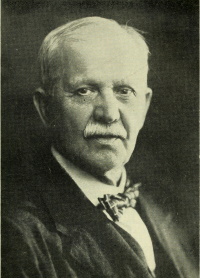

Walter Grey Dunnington (16 February 1850–1 August 1922), tobacco merchant, was born in Farmville and was the son of Sallie Ann Madison Dunnington and James William Dunnington, a leaf tobacco dealer. After attending a local academy, he moved to Kansas City, Missouri, to pursue business opportunities. His mother's death prompted his return to Farmville in the mid-1870s. There Dunnington married India Wycliffe Knight on 12 October 1876. Of their six children, three sons and two daughters survived infancy.
Dunnington took over his father's tobacco business and made it one of the largest brokerages in the region. W. G. Dunnington and Company specialized in dark-fired tobacco, although it also took advantage of the growing demand for bright-leaf tobacco that the emergent cigarette-manufacturing business had prompted. As his business grew, Dunnington leased warehouses and factories to facilitate larger export shipments. He overcame potentially serious setbacks in 1898, when fire destroyed several of his factory buildings in Farmville, and in 1900, when another conflagration consumed more than one million pounds of leaf tobacco at his Petersburg warehouse. Dunnington quickly recovered, and his company became a major presence in the markets of Danville, Lynchburg, and Petersburg, and in Louisville, Kentucky. In 1909 he purchased as much as 30 million pounds of Kentucky's dark-fired tobacco for export.
Focusing on international trade, Dunnington was operating as a buyer for the Austria-Hungarian government by 1900. About that time he and a partner became dealers for the Italian government's regie, or tobacco monopoly, and after 1903 Dunnington was the regie's sole tobacco buyer in western Kentucky and Tennessee. He transformed the markets in that region by bypassing local auctions and instructing his district agents to deal directly with farmers in order to keep his prices for the leaf as low as possible. In 1905 the United States Bureau of Corporations examined the practices of Dunnington and the regie as part of an investigation into the British-American Tobacco Company trust but later dropped the inquiry. The low prices dictated by Dunnington's control of competition drove some desperate tobacco farmers, known as Night Riders, to violence, including the destruction of tobacco warehouses in Kentucky and Tennessee, and when a fire in 1908 destroyed more than a million pounds of tobacco in Dunnington's Lynchburg factories, some held the Night Riders responsible. Dunnington also dealt extensively with Norwegian interests, and newspaper accounts early in the twentieth century occasionally commented on his massive shipments of tobacco to Norway. World War I disrupted his business with Austria-Hungary, but he remained active in other European markets during and after the conflict.
Dunnington pursued additional business interests. He became a director of the Farmville and Staunton River Railroad Company when it reorganized in 1884. Dunnington and a partner established in 1896 the Virginia State Fertilizer Company. It operated in Farmville until 1909, when his partner moved the operation to Norfolk. Dunnington helped organize the First National Bank of Farmville in 1900 and served briefly as a director. He was also a director of the National City Bank in Washington, D.C., which opened in 1905.
During the 1880s Dunnington sat for a short time on the Farmville town council. He acquired an interest in the local waterworks in 1900 and was elected a director of the Farmville Water, Light, Heat and Power Company. As president of the Farmville Board of Trade during the first decade of the twentieth century, Dunnington promoted the area and sought increased business development. He also served on the board of trustees for nearby Hampden-Sydney College from 1897 until 1919.
During the 1890s Dunnington acquired Poplar Hill, his wife's childhood home in Prince Edward County, where he raised tobacco and other crops and constructed an imposing brick mansion. Walter Grey Dunnington died of colon cancer on 1 August 1922 at his home. He was buried in Westview Cemetery.
Sources Consulted:
Biographies in Philip Alexander Bruce, Lyon Gardiner Tyler, and Richard L. Morton, History of Virginia (1924), 5:321–322, Charles Edward Burrell, A History of Prince Edward County, Virginia: From Its Formation in 1753, to the Present (1922), 320–321 (variant birth date of 12 Feb. 1849, variant death date of 2 Aug. 1922, and portrait facing 314), and Record of the Hampden-Sydney Alumni Association 4 (Oct. 1929): 6; self-reported birth date of 16 Feb. 1850 in passport application, 3 Aug. 1921, General Records of the Department of State, Record Group 59, National Archives and Records Administration (NARA), Washington, D.C.; United States Census Schedule, Prince Edward Co., 1900 (with birth date of Feb. 1850), Records of the Bureau of the Census, Record Group 29, NARA; Prince Edward Co. Marriage Register; correspondence and business records in Walter Grey Dunnington Papers, on deposit at Virginia Museum of History and Culture, Richmond; Farmville Herald, 11 Apr. 1902; Farmville Herald and Farmer-Leader, 23 Feb. 1940; Today and Yesterday in the Heart of Virginia: A Reprint of the Edition of the Farmville Herald, March 29, 1935 (1935), 106–107; Herbert Clarence Bradshaw, History of Prince Edward County, Virginia…. (1955); Bradshaw, History of Farmville, Virginia, 1798–1948 (1994); Christopher Waldrep, Night Riders: Defending Community in the Black Patch, 1890–1915 (1993), esp. 26–33; Death Certificate, Prince Edward Co., Bureau of Vital Statistics, Commonwealth of Virginia Department of Health, Record Group 36, Library of Virginia; obituaries (all with variant birth date of 12 Feb. 1849) in Richmond News Leader, 2 Aug. 1922, Richmond Times-Dispatch, 3 Aug. 1922, and Farmville Herald, 4 Aug. 1922.
Photograph in Burrell, History of Prince Edward County, Virginia.
Written for the Dictionary of Virginia Biography by John M. McClure.
How to cite this page:
John M. McClure, "Walter Grey Dunnington (1850–1922)," Dictionary of Virginia Biography, Library of Virginia (1998– ), published 2022 (http://www.lva.virginia.gov/public/dvb/bio.asp?b=Dunnington_Walter_G, accessed [today's date]).
Return to the Dictionary of Virginia Biography Search page.


